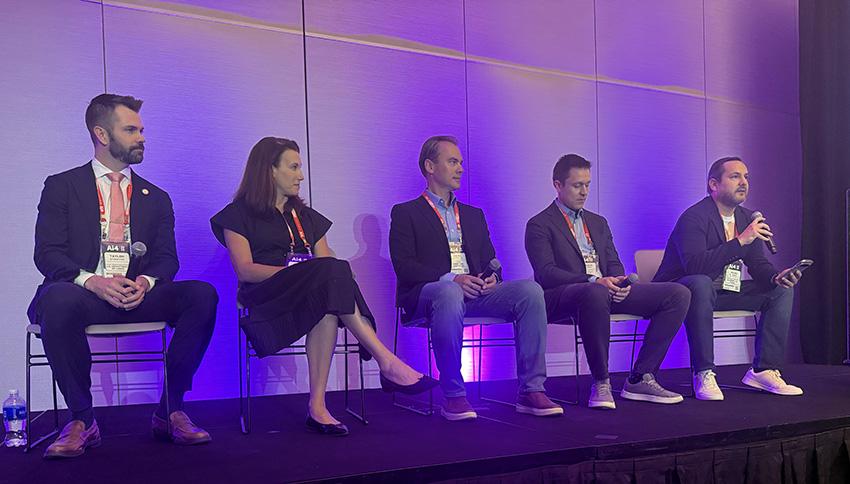The Economic Impact of AI: Jobs, Productivity, and Future Economies
At a todays Ai4 conference in Las Vegas, the panel discussion titled “The Economic Impact of AI: Jobs, Productivity, and Future Economies”, CIJ EUROPE listened to experts from academia, industry, and government explored how artificial intelligence is reshaping productivity, labour markets, and long-term economic structures. The conversation balanced optimism about AI’s potential with caution about the transition period, stressing the importance of data-driven decision-making and strategic workforce planning.While participants agreed that AI has the potential to drive growth and innovation, they cautioned that the transition will be gradual, uneven, and dependent on both strategic adoption and workforce readiness.
Early Adoption and the Productivity J-Curve
Gregor Schubert, Professor at UCLA, opened by noting that many organisations are still in the early “J-curve” phase of AI implementation—where investment, experimentation, and workflow adjustments can temporarily slow productivity before gains emerge. He stressed that meaningful economic impact is more likely to appear over the next five to ten years as use cases mature and processes are restructured.
Schubert also argued that AI’s impact should be measured at the task level rather than assuming entire jobs will be eliminated. Most roles, he said, consist of bundles of tasks—some suited to automation, others not—leading to a reconfiguration of work rather than wholesale displacement.
Engineering, Skills, and Integration Challenges
Pavel Kolelev, CTO at a technology startup, highlighted the engineering realities of integrating AI into production workflows. While certain coding tasks can be accelerated, the technology is still maturing, and human oversight remains critical. He stressed that effective deployment depends on reskilling software engineers to work alongside AI tools, as well as overcoming organisational barriers to adoption.
Kolelev warned that productivity gains in AI-enabled coding may be overstated in public discourse, noting that integration into complex systems requires time, iteration, and cultural acceptance within engineering teams.
Data-Driven Insights on AI Use
Sarah Hecht, Head of Policy at Anthropic, emphasised the importance of empirical evidence in understanding AI’s economic role. Through the company’s Economic Index, Anthropic has tracked adoption trends across sectors, noting high usage in software, education, creative industries, and marketing.
Her research distinguishes between “augmentation” tasks—where AI assists human work—and “automation” tasks—where AI performs functions independently. Notably, she observed a recent rise in automation following the release of Anthropic’s agentic coding tools, especially among software engineers.
Hecht also flagged a significant point: AI’s first wave is affecting high-wage, white-collar jobs, such as software development—an occupational class often insulated from technological disruption. This, she said, raises important questions about reskilling and career evolution for skilled professionals.
Government Strategy and Workforce Agility
Taylor Stockman, Chief Innovation Officer at the U.S. Department of Labour, framed AI as a net-positive for job creation, particularly in three categories:
1. AI Development Roles – building and maintaining AI systems.
2. AI-Integrated Industry Jobs – roles in sectors like healthcare and marketing that embed AI into daily functions.
3. Infrastructure Roles – jobs linked to the construction and maintenance of data centres and AI-related facilities.
Stockman said the government’s priority is ensuring equitable access to these opportunities regardless of geography or income level. Initiatives include AI literacy programmes, apprenticeships, and a new AI Workforce Research Hub to monitor and adapt to labour market changes.
He also countered common displacement narratives, arguing that employers often use AI to increase output rather than cut headcount, and that workforce systems must be agile enough to meet evolving skill demands.
Beyond the Workplace: Broader Societal Benefits
Panelists agreed that AI’s economic impact extends beyond corporate productivity. Schubert noted that consumer use of AI tools for education, information access, and personal projects represents a significant but under-measured source of welfare gains.
Hecht pointed to potential high-impact domains—biosciences, education, and government services—where AI could accelerate research, personalise learning, and improve service delivery. She stressed that public sector adoption could also rebuild trust in institutions if deployed responsibly.
Skills for the AI Economy
When asked which skills will be most valuable, Stockman identified foundational AI literacy as essential “table stakes” for workers. Beyond technical capabilities, he stressed the growing importance of uniquely human competencies—such as empathy, communication, and trust-building—especially in professions like healthcare, where AI may handle diagnostics but human connection remains irreplaceable.
Shifting the Narrative
The discussion closed with a call to move the public conversation from fear to optimism. Panelists noted that AI literacy gaps, cultural hesitancy, and misconceptions about “cheating” when using AI tools can slow adoption. They urged leaders in business, government, and education to frame AI as an empowering technology that can expand opportunity—if supported by the right policies, skills, and strategic planning.
As Schubert concluded, AI is a general purpose technology—akin to electricity or the internet—with no set playbook for integration. Navigating this transformation will require coordinated effort, investment in human capital, and a willingness to adapt as both technology and economic structures evolve.









